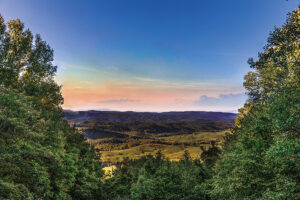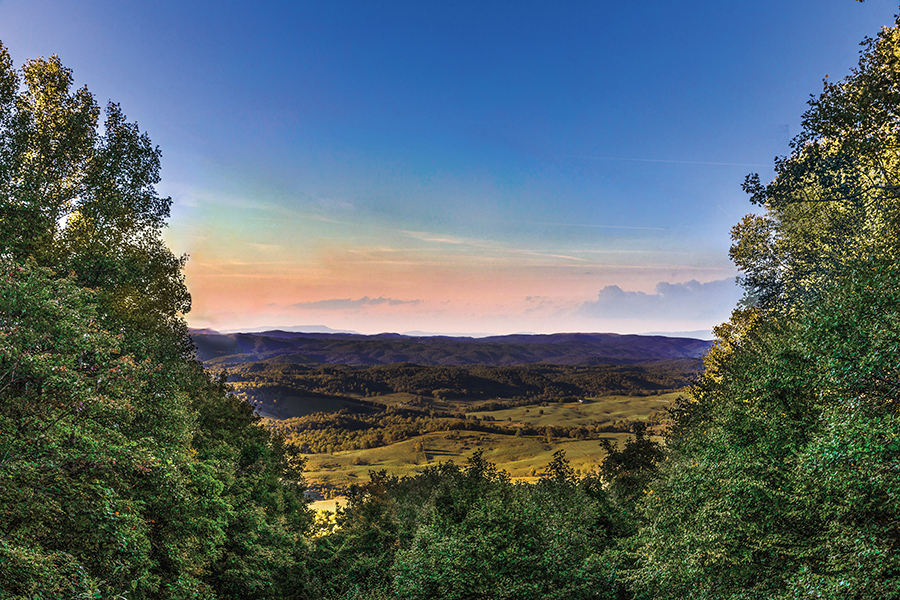Spotlight: Greenbrier Valley
Lewisburg and White Sulphur Springs beckon visitors with a combination of history, adventure and small-town charm.

Nestled in the southeastern hills and mountains of West Virginia, the stunning Greenbrier Valley is home to the famed Greenbrier resort and the historic towns of White Sulphur Springs and Lewisburg.
The first guests visited the grounds of what would become The Greenbrier in 1778, coming to “take the waters” at the mineral spring that bubbled up there. Over the years since, the internationally known resort has been a favorite destination of royalty, celebrities and business leaders. Twenty-eight U.S. presidents have stayed there.
Today The Greenbrier is situated on 11,000 acres of land with more than 700 guest rooms and suites, 10 restaurants, five golf courses, dozens of indoor and outdoor activities, an enormous spa, a sophisticated medical clinic and a host of boutique shops.
If you’re planning to visit The Greenbrier, make sure to schedule a tour of what for 30 years was the resort’s best-kept secret — a Cold War underground bunker designed to shelter members of the U.S. Congress in the event of a nuclear attack or other national emergency.
The village of White Sulphur Springs, located only minutes from the front gate of The Greenbrier, lures countless visitors every year with its small-town charm and a variety of specialty shops and restaurants.
Many visitors to White Sulphur Springs enjoy touring the National Fish Hatchery. Opened in 1900, it’s one of 65 federally owned fish hatcheries in the United States but one of only three producing rainbow trout. It produces 10 million trout eggs a year. The eggs are then shipped nationwide to federal, state and tribal hatcheries. The hatchery is open to the public for guided and self-guided tours Monday through Friday from Memorial Day through Thanksgiving. The visitors’ center offers exhibits, aquariums and a display pool.
Just beyond White Sulphur Springs, nearly a million acres of wilderness await exploration. As one of the 10 designated Mon Forest Towns — gateway towns in and around the Monongahela National Forest — White Sulphur Springs offers an ideal starting point for outdoor adventures. A short drive brings visitors to the New River Gorge National Park & Preserve, home to premier rock climbing, whitewater rafting and hiking. To the north, winter sports enthusiasts can find snow skiing at several top resorts, while the nearby Lake Sherwood and Blue Bend recreation areas offer hiking, fishing and mountain-style beaches.
Lewisburg is located just a few minutes’ drive along the Midland Trail/U.S. 60 from The Greenbrier and White Sulphur Springs. The seat of Greenbrier County and a regional trading center for the rolling countryside known as the Big Levels, Lewisburg has retained much of the appearance and charm of a quiet village of the Old South.
“Lewisburg is the perfect spot to escape big-city life,” said Chelsea Ruby, secretary of the West Virginia Department of Tourism. “It’s a picture-perfect small town with a charming
downtown, thriving arts scene and accessible outdoor recreation.”
Not surprisingly, Lewisburg has been dubbed “America’s Coolest Small Town.”
The town is named for Andrew Lewis. Born in Ireland in 1720, Lewis moved to Virginia with his parents in 1729. In 1751, he came to the Greenbrier Valley as a surveyor. He discovered a spring behind where the county courthouse now stands. The spring became known as Lewis Spring.
Families who settled in the Greenbrier Valley found rich land and abundant game; however, the early settlements were often disrupted by conflicts with Native American tribes who inhabited the Ohio Valley. In 1755 Andrew Lewis built a crude fort to protect the area’s settlers.
In 1774 the Royal Governor of Virginia, Lord Dunmore, ordered Lewis to assemble a militia for an expedition against the united Shawnee, Delaware, Mingo and Ottawa tribes under Shawnee Chief Cornstalk. Lewis assembled the army, and it set off on the Big Levels, now Lewisburg, naming the assembly area Fort Union. After an arduous march of 161 miles, the militia met and defeated Chief Cornstalk’s forces at the Battle of Point Pleasant on the Ohio River. Some have described the battle as the first of the American Revolution, but most historians scoff at that claim.
Downtown Lewisburg offers a comfortable mix of the past and present. Many 18th- and 19th-century buildings remain, tastefully updated and put to new uses as shops, offices and restaurants. In 1978, a 236-acre area in the heart of Lewisburg was designated an historic district on the National Register of Historic Places. From the downtown radiates a network of wooded streets lined with sturdy homes of brick, frame or local limestone. Many of the homes have been in the same family for generations.
One of the many fine homes built in Lewisburg in the early 1800s was the Withrow House, constructed in 1834. Flash-forward to the 1920s when a young couple, Randolph and Mary Milton Hock, moved to Lewisburg with the idea of turning the old Withrow House into a hotel. The General Lewis Inn opened in 1929 and continues to welcome travelers.
The General Lewis Inn is furnished with original Colonial furniture, much of it found in old homes in the Lewisburg area. Spool and poster beds, chests of drawers, bright coverlets and quilts, fine china and glassware, old prints and other items add to the hotel’s charm.
Lewisburg’s Carnegie Hall was built in 1902 with $33,000 donated by steel baron and philanthropist Andrew Carnegie to the former Lewisburg Female Institute, later the Greenbrier College for Women. After the college closed, Carnegie Hall Inc. was incorporated as a regional arts and education center. Today, it hosts live performances by musical artists from around the world.
Built in 1820, the North House Museum, at 814 Washington St. in Lewisburg, contains the collections of the Greenbrier Historical Society, including many of the finest examples of early Virginia furnishings. The museum is open Monday through Saturday from 10 a.m. to 4 p.m.
The inscription on the base of the striking Confederate Monument in Lewisburg reads, “In Memory of Our Confederate Dead.” The Confederate Cemetery on the edge of the downtown is the final resting place of 95 soldiers killed in the Battle of Lewisburg on May 23, 1862, and the nearby Battle of Droop Mountain on Nov. 6, 1863.
Lewisburg’s Old Stone Church, located at Church and Foster streets, is the oldest church in continuous use west of the Allegheny Mountains. The original congregation was established in 1783, and the current building was constructed in 1796. It’s built of limestone blocks that are said to have been brought on horseback from the banks of the Greenbrier River — 4 miles away — by the women of the church. The interior of the Old Stone Church has been rearranged; but the original pews, balcony (where slaves sat) and pulpit remain. During the Civil War the church was used as a military hospital and later for billeting troops. Today, the church is still in use as Old Stone Presbyterian Church.
After a busy schedule of sightseeing, you may think it’s time to eat. If so, Lewisburg’s walkable downtown historic district has more than a dozen locally owned restaurants
specializing in everything from burgers and tacos to fine French and Italian cuisines.
If you’d like to quench your thirst, again you have a number of spots to choose from. Hand-crafted, small batch production of beer, spirits and cider is flourishing in the Greenbrier Valley, and most producers welcome visitors to their facilities.
Photos courtesy of Experience Greenbrier Valley
